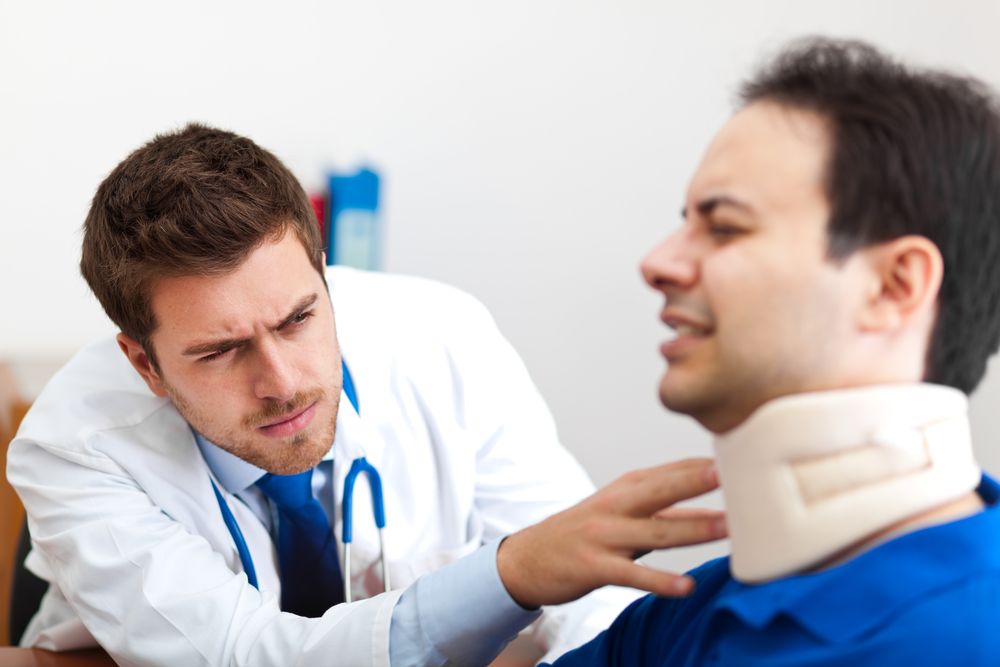 Most people who are in car and truck accidents suffer from neck and back pain. Sometimes after undergoing diagnostic tests, they find out that the cushion-like disks that separate the bones (vertebrae) in their backbones have been damaged. This especially happens in rear-end collisions. Your doctor may have told you that you have one or more herniated and bulging disks. This post discusses what this means and what you can do about these often serious medical problems.
Most people who are in car and truck accidents suffer from neck and back pain. Sometimes after undergoing diagnostic tests, they find out that the cushion-like disks that separate the bones (vertebrae) in their backbones have been damaged. This especially happens in rear-end collisions. Your doctor may have told you that you have one or more herniated and bulging disks. This post discusses what this means and what you can do about these often serious medical problems.
What is a herniated disk?
A herniated disk happens if the outside of the annulus fibrosis, the disk’s outer cover, ruptures or tears. Some of the soft nucleus puplosus, the jelly-like material inside the disk that gives it the shock-absorbing quality to protect your vertebrae, leaks out.
Sometimes it escapes into the spinal canal, often contacting a spinal nerve root. Enormous pain and other symptoms can result.
Herniated disks progress in stages going from smaller to the most extreme: prolapsing, protruding, extruding, to sequestering. In that last state, the material inside the disk has severed from the disc.
They are also referred to as ruptured or slipped disks and the pain can be called a pinched nerve.
Adding to the complexity of a correct diagnosis, herniated disks do not always cause extreme discomfort. At other times, the symptoms are more like those from bulging disks that are described below.
Further, while they can be caused by the sudden trauma of being crashed into by another vehicle, they can also be caused by aging, falls, other injuries, or other factors.
What is a bulging disk?
By comparison, a bulging disk works from the inside out and does not tear the annulus. Normally, the outside of the disk falls into line with the outside of the bone that it is attached to. But if the bulge extends by more than three millimeters, a bulge is diagnosed.
Bulging disks can also be difficult to diagnose correctly. While a vehicle crash can be the cause, other factors including aging, poor posture, a weak core, and excessive weight can also contribute to the problem.
They may or not cause pain, depending on whether a spinal nerve root or the cord itself is being impinged upon. The keys are how large the bulge is and where it is located.
Symptoms of both herniated and bulging disks
They can include the following:
- pain
- numbness, weakness, and spasms, especially down one arm and into the hand or fingers (if neck) or buttocks, calf, or foot or toes (if low back)
- difficulty standing, sitting, and walking
- loss of bladder control, and/or
- soreness and pain around the “saddle area.”
Diagnosis
It is necessary to be seen by an orthopedic surgeon, neurologist, or neurosurgeon who has more expertise in this area. However, many primary care physicians are able to make the initial diagnosis.
He or she will take your history and perform a physical examination of your neck or back. They will have you move them into different positions to track the source of your pain and see what your limiations are. They check for muscle strength, reflexes, sensations, and movement.
X-rays will not show these damaged disks but they can rule out other sources of pain, primarily broken bones.
Doctors will also need confirmation from sophisticated diagnostic tools.
Tools
High tech machines and procedures can help you learn whether you have damaged your discs. These include the following:
- Magnetic resonance imaging (MRI) – a strong magnetic field and radio waves create detailed cross sectional imagery that show the damaged disks
- Computerized tomographs (CT) – a scanner takes multi-dimensional x-rays and combines them to form a cross-section image that can show tears
- Electromyogram (EMG) – a test with the insertion of needles that measure the electrical activity of nerves and muscles. It is often performed with nerve conduction studies.
- Myelogram – a procedure used prior to surgery after other tests have shown the herniation or severe bulge. Dye is injected and x-rays can reveal exactly where the problem is.
Treatment
Different people obviously react to different treatment plans. Some can have their symptoms relieved with conservative therapy including the following:
- physical therapy
- electric stimulation
- rolling on chiropractic table or using machines
- cold laser
- ice and heat
- massage
- soaking baths with Epsum salts
- anti-inflammatories and pain-relieving medications and
- over-the counter medicines (ibuprofen or naproxen)
Doctors may prescribe stronger medications and perform cortisone injections.
Other ways that the neck and back pain can diminish include lifestyle change options including
- Rest – but not too much lying in bed or sitting in a chair
- light exercise and
- dietary changes
Surgery
As a last resort, depending on the severity, placement, and size of the herniated and bulging disks, a doctor may perform surgery after the conservative measures have not alleviated the symptoms.
The scope of surgery varies widely, from excising a small part of the damaged disk to fusing several together
We can help you
Some of our clients have also benefitted from other ideas that we discuss on a one-on-one basis.


